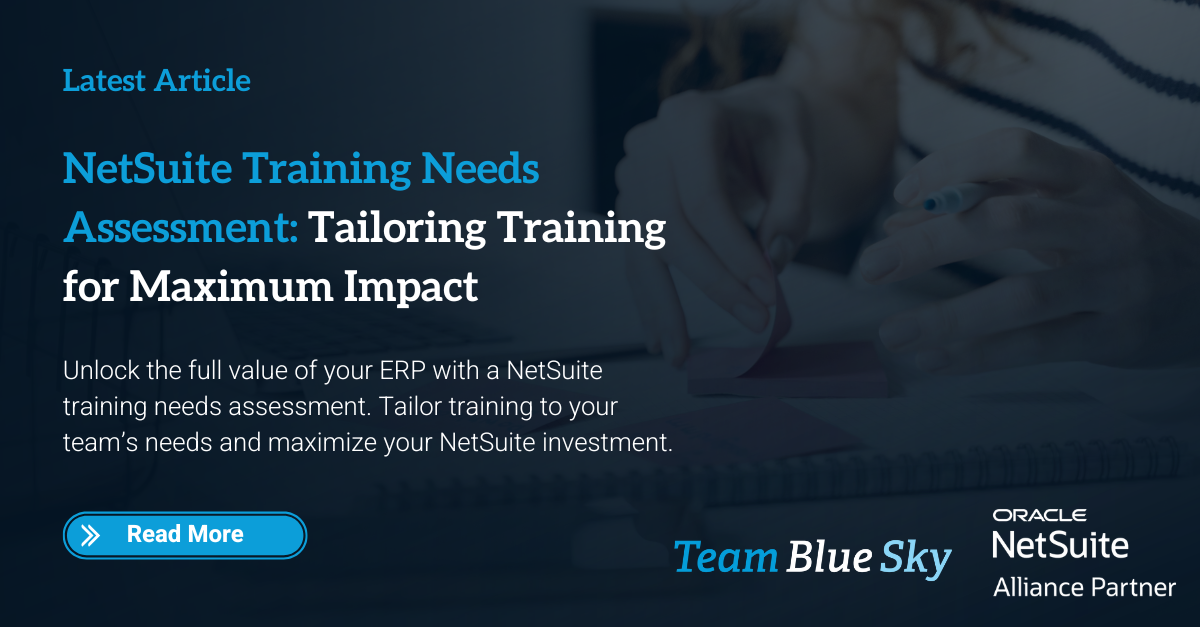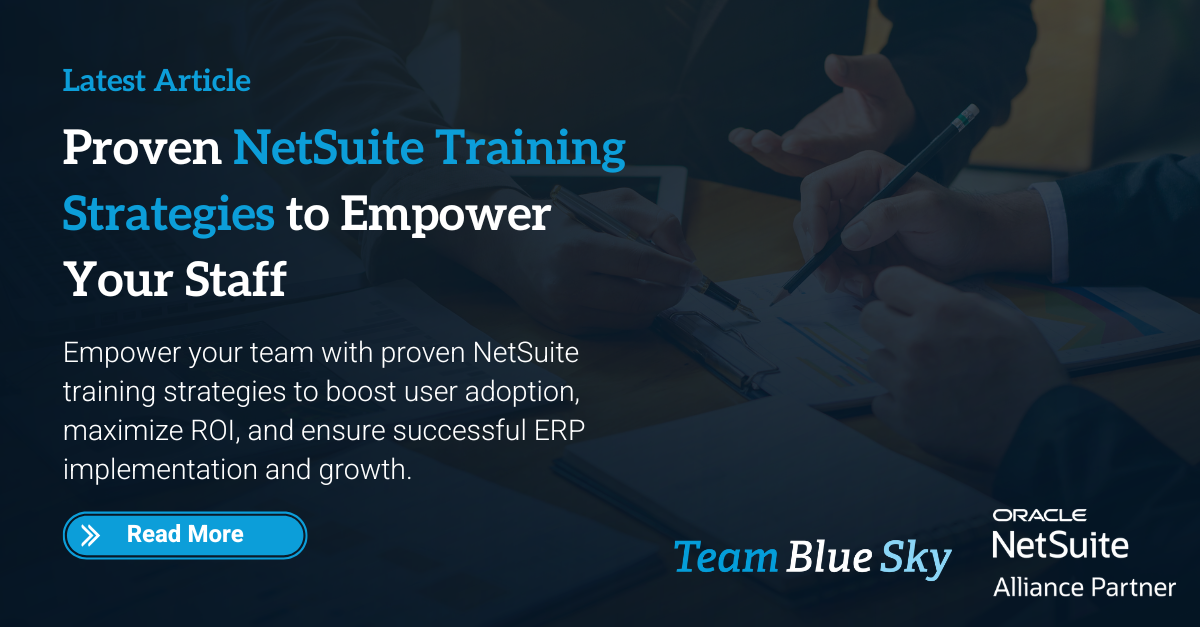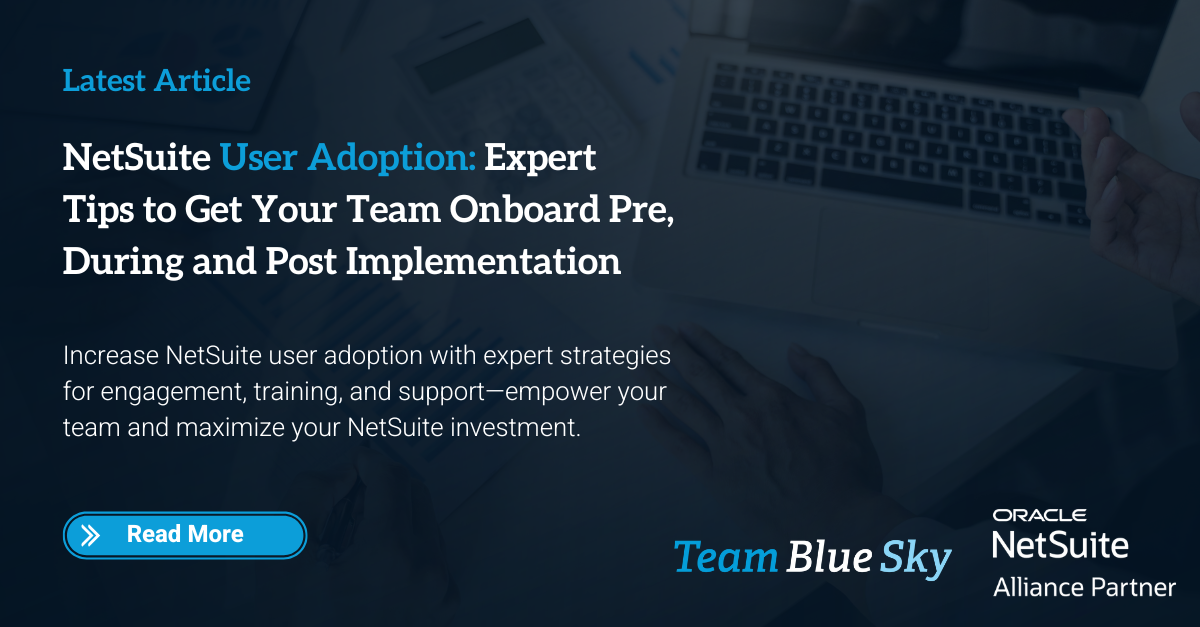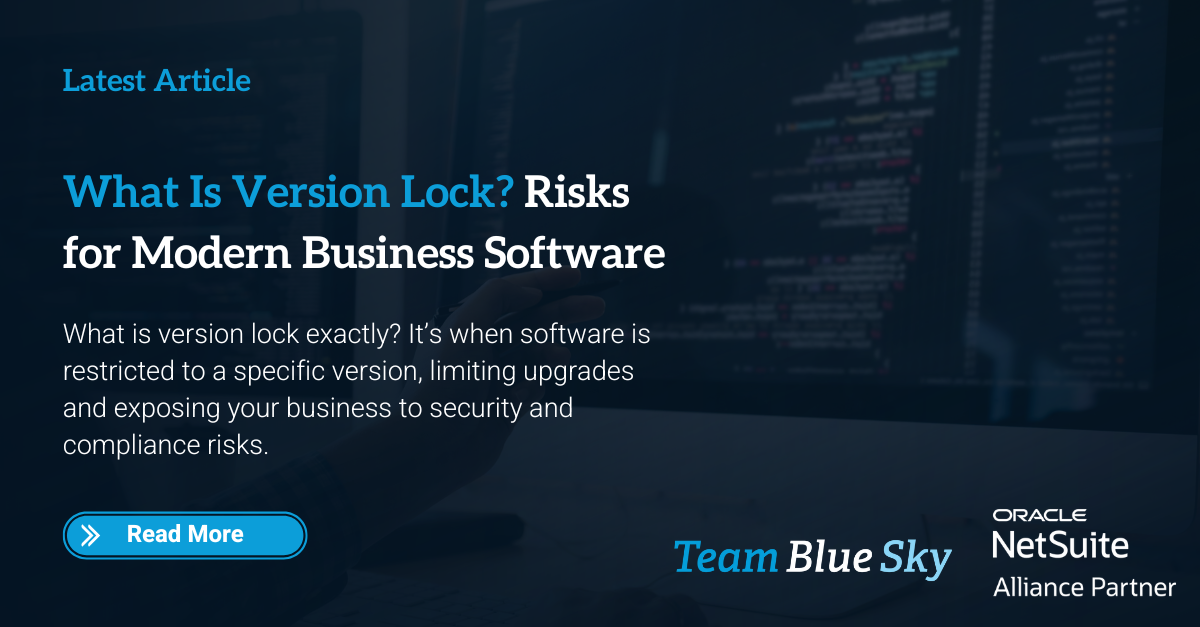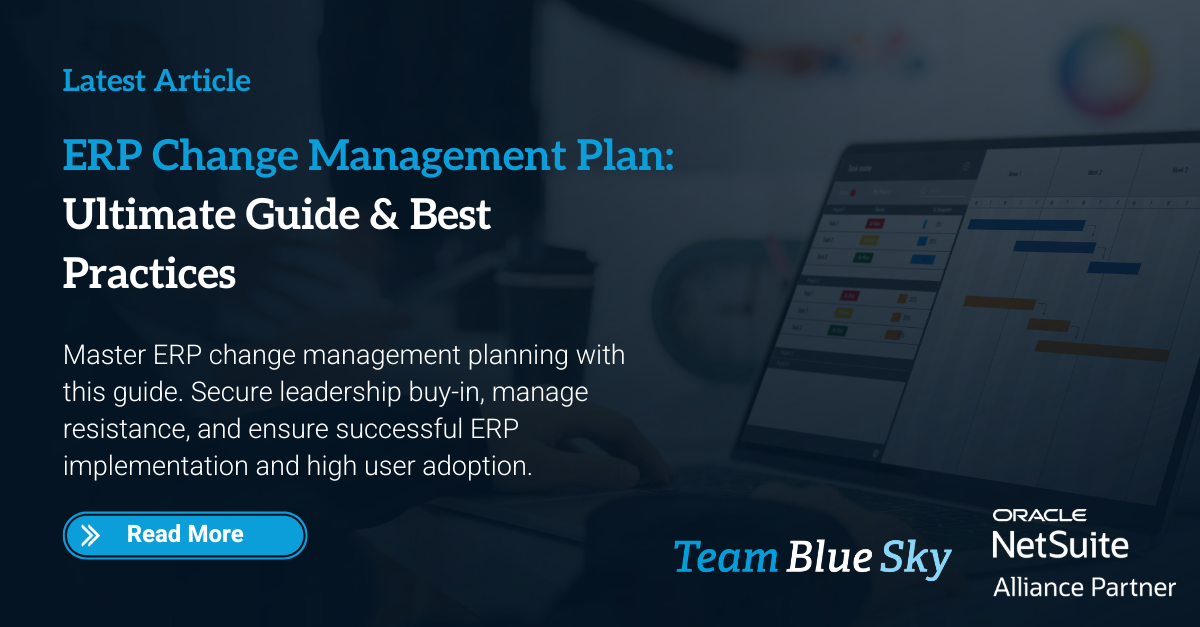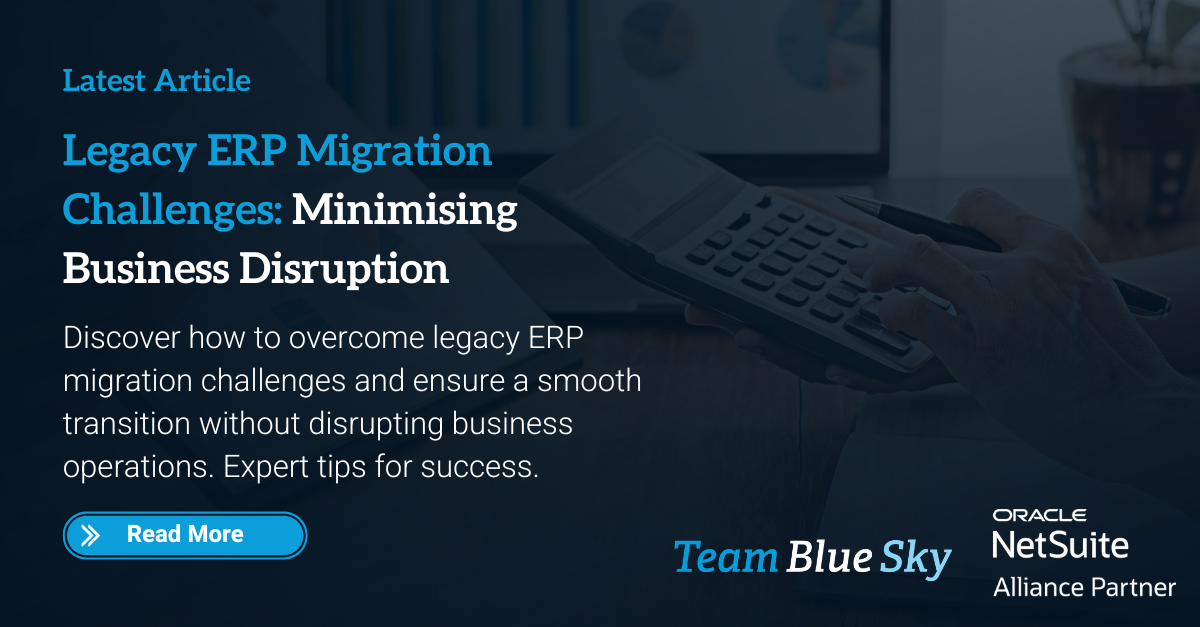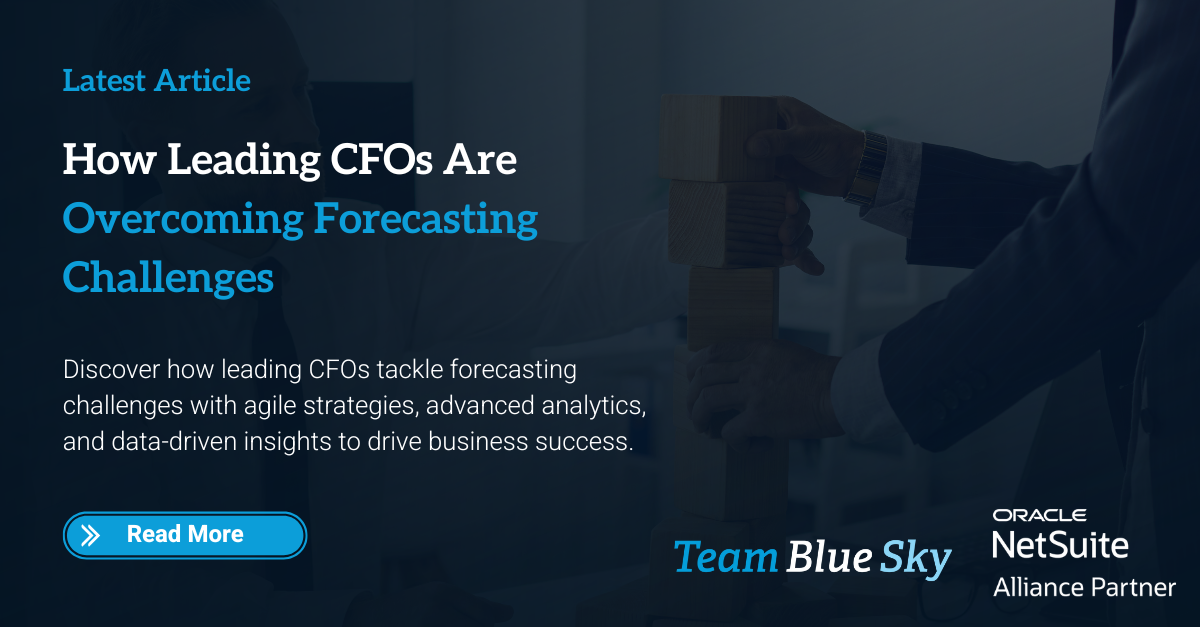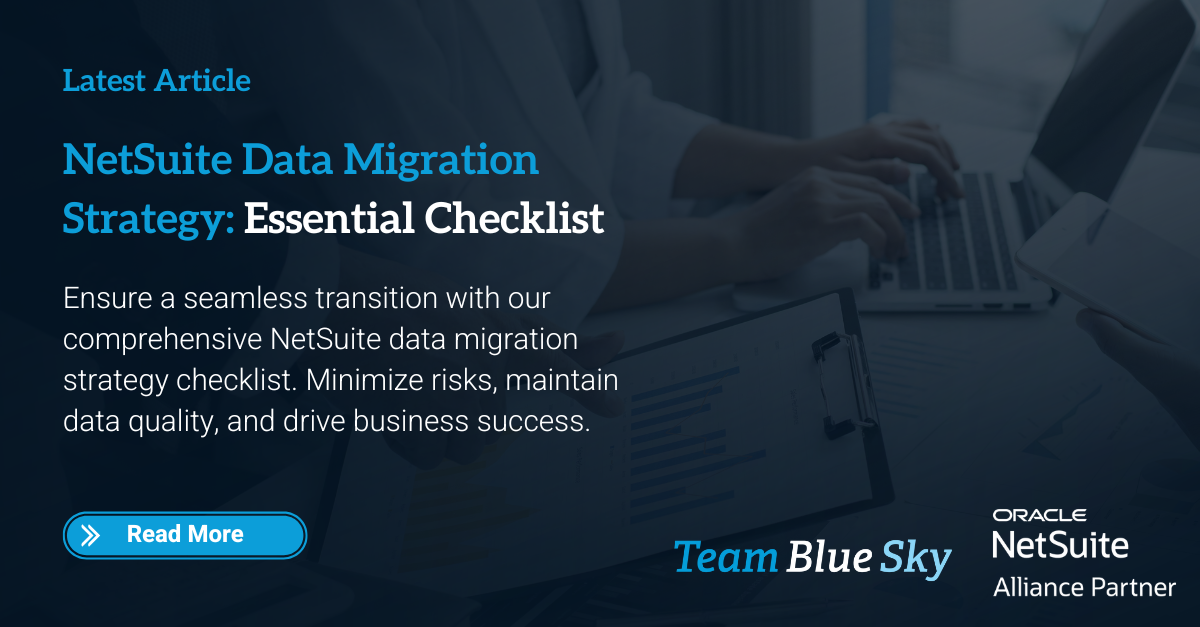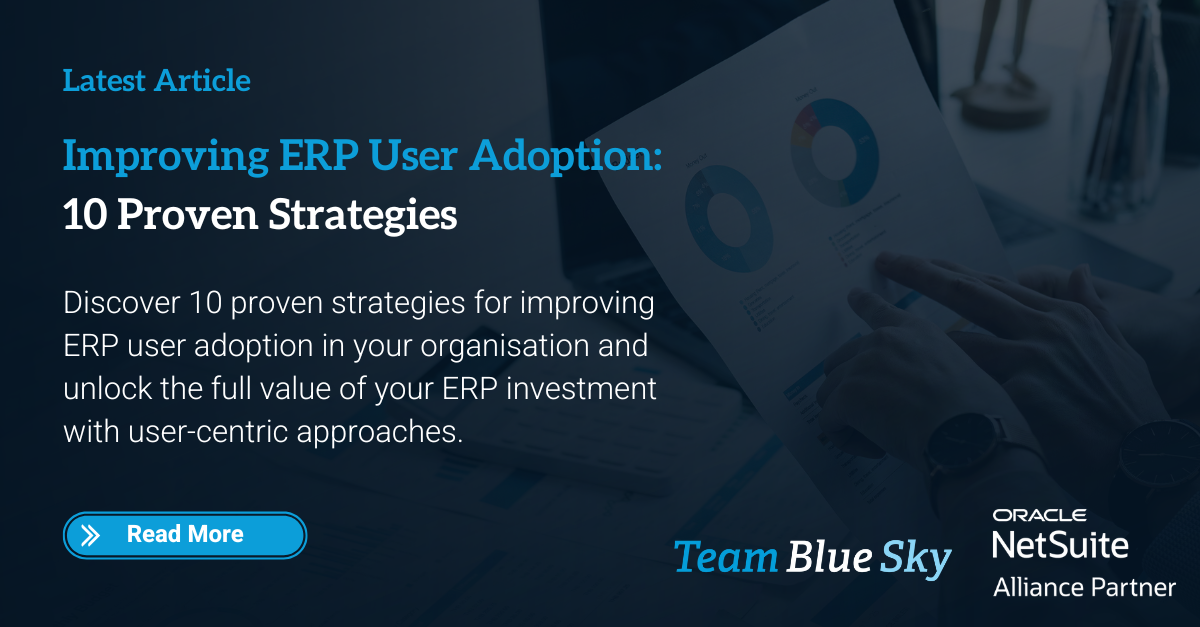NetSuite Adoption Communication Plan: Best Practices for Employee's and Key Stakeholders
This guide aims to provide new NetSuite customers with a comprehensive, lifecycle-based framework for mastering NetSuite user adoption. We argue that successful adoption is not a one-time project phase but a continuous, strategic discipline that directly drives ROI. Traditional approaches, focused heavily on go-live and basic training, are insufficient for complex systems like NetSuite and modern business demands. This blueprint moves beyond tactical tips to provide a structured methodology grounded in change management, behavioral psychology, advanced analytics, and platform-specific expertise. It outlines the critical groundwork for strategic alignment, the human-centric design of enablement programs, the utilisation of digital catalysts such as DAPs and the importance of tailoring strategies to NetSuite's unique architecture.
The report culminates in the introduction of two proprietary models: the Tiered NetSuite Adoption Metrics Framework, for measuring what truly matters, and the NetSuite Adoption Maturity Model, a roadmap for organisations to assess their current state and chart a course toward becoming an insight-driven enterprise.
The Foundation - Strategic Alignment and Governance
The success or failure of a NetSuite implementation is often determined long before the first user logs in. The most sophisticated training programs and post-launch support initiatives cannot compensate for a weak foundation. This initial phase of strategic alignment and governance lays the groundwork for user high adoption. It requires moving beyond a purely technical project management mindset to one that embraces strategic business outcomes, active executive sponsorship, and clear, collaborative governance structures. Failure to invest adequately in this foundation is the primary and most common cause of the downstream adoption challenges that plague so many ERP projects, from user resistance to a failure to realise the expected return on investment.
Defining Success Beyond Go-Live: Establishing Business-Outcome KPIs
The single most prevalent mistake in ERP implementations is defining "success" as a technical go-live. While a stable, functioning system is a necessary milestone, it is not the goal. The true measure of success is the achievement of predefined business objectives that the NetSuite investment was intended to enable. To secure user adoption, the project's purpose must be framed not in terms of software deployment but in terms of tangible business improvements.
This requires establishing clear, measurable key performance indicators (KPIs) from the outset. These KPIs should be business-centric, not technical. Examples include "reducing time-to-hire by 25%," "automating 80% of payroll processes," or "achieving 90% user adoption within the first six months". For a finance department, a key objective might be to "reduce the month-end close cycle by 40%." For an operations team, it could be "improving on-time delivery rates by 15%."
These outcome-based KPIs serve a dual purpose. First, they provide stakeholders with concrete metrics to measure progress and justify the investment. Second, and more importantly for adoption, they form the basis of a compelling "value narrative". This narrative is the story that explains why the change is happening. It must clearly link the adoption of NetSuite to the organisation's overarching strategic ambitions and, crucially, translate that high-level vision into a specific, relevant benefit for each user group. This narrative answers the fundamental question every employee will ask: "What's in it for me?". Without a clear and compelling answer to this question, user motivation will falter before the project even begins.
The Three Pillars of Buy-In: Securing Active Sponsorship
Passive approval from leadership is a recipe for failure. A successful NetSuite implementation requires active, visible, and unwavering sponsorship from three distinct and critical groups: executive leadership, department heads, and influential end-users. Securing this tri-level buy-in creates a powerful coalition that can drive change throughout the organisation.
Leadership
Executive support must go far beyond signing the check. Management cannot simply "step aside" and let the project team proceed; this will inevitably lead to resistance. Instead, they must become the project's most vocal and consistent advocates, actively pushing their teams toward acceptance and articulating the strategic vision. To secure this level of commitment, the project team must demonstrate the high-level business value, showcasing how NetSuite's tools, reports, and KPIs will provide them with increased visibility and enable them to manage their teams and scale the business more effectively. Furthermore, strong executive sponsorship is essential for securing the necessary resources, budget, and authority to make critical decisions and overcome organisational inertia.
Department Heads and Team Leaders
These individuals—the process owners and subject matter experts—are often the most critical and challenging group to win over. As senior resources, they may exhibit significant resistance due to comfort with existing systems, a reluctance to relinquish control, or a deep-seated belief that "this is how we've always done it". The strategy for engaging them must be rooted in empathy and respect for their expertise. It begins by listening. Project teams should leverage these leaders' emotional attachment to their departments by allowing them to detail their current processes, business challenges, and pain points. Only after demonstrating a thorough understanding of their world can the project team effectively show precisely how NetSuite will improve their specific departmental processes. This approach transforms them from potential adversaries into collaborators and cultivates a sense of ownership over the new solution, which is a powerful motivator for adoption.
End-User Influencers (Champions)
Within every organisation, there are employees who exhibit a natural enthusiasm and aptitude for new technology. Identifying, empowering, and formalising the role of these "NetSuite Champions" or "super-users" is one of the most cost-effective and powerful adoption strategies available. These individuals serve as a trusted, first line of defense for their peers. They act as internal trainers, mentors, and advocates, providing peer-to-peer support, addressing concerns, and sharing best practices. Their influence is potent because it leverages the psychological principle of social proof. Users are far more likely to accept guidance and embrace a new system when they see a trusted colleague succeeding with it.
Forming the Implementation Task Force: Roles, Responsibilities, and Collaboration
A successful implementation requires a dedicated, cross-functional task force with representatives from every department the system will impact. This team is the engine of the project and must include members from core functions like finance, HR, and IT, and representatives from sales, marketing, operations, and any other key user group. The composition of this team is critical; a failure to include representatives who understand the day-to-day realities of front-line work is a primary cause of poor adoption, as high-level process owners may inadvertently approve workflows that are impractical for the people who must use them.
Each member of the task force must have clearly defined roles and responsibilities to ensure efficiency and accountability. The project lead, for instance, must be a champion who can effectively bridge the gap between technical IT capabilities and strategic business needs. The NetSuite Administrator is another pivotal role, responsible not just for technical maintenance but for the ongoing configuration of the user experience, including roles, permissions, and dashboards.
A forward-thinking organisation will view this task force not merely as a temporary project management body, but as the seed of a future, permanent NetSuite Center of Excellence (CoE). While a project team disbands after go-live, the need for system governance, process optimisation, and continuous user enablement is perpetual. By structuring the initial task force with the explicit goal of transitioning its key members—the champions, process owners, and NetSuite Administrator—into a permanent CoE, the organisation makes a strategic investment. This reframes the initial setup cost as the foundation for a long-term strategic asset responsible for maximising the value of the NetSuite platform indefinitely.
The Implementation Roadmap: Strategic Choices and Communication
The implementation roadmap is the master plan that guides the project from conception to completion. It begins with a critical strategic choice: the implementation approach. Organisations must decide between a "phased rollout" or a "full-scale, all-at-once" (or "big bang") implementation. The phased approach introduces NetSuite functionality gradually, allowing teams to adjust to changes and resolve issues before additional modules are introduced. The big bang approach unleashes all features simultaneously, which can deliver benefits faster but carries a much higher risk of overwhelming staff and introducing errors.
This decision should not be viewed as purely technical or logistical. It is, fundamentally, a change management strategy. The principles of behavioral psychology demonstrate that humans adapt better to small, incremental changes (Weber's Law) and are easily overwhelmed by excessive information (Miller's Law). A big bang rollout maximises cognitive load and psychological resistance by forcing a massive, simultaneous change across the entire organisation. A phased rollout, by contrast, aligns perfectly with these psychological principles. It breaks the change down into manageable, digestible steps, allowing users to learn, adapt, and provide feedback in cycles. Therefore, the phased approach should be considered the default, psychologically sound best practice for maximising user adoption. The big bang strategy should be reserved only for situations of extreme and unavoidable business necessity.
Once the approach is chosen, a detailed roadmap must be developed. This document should outline all key milestones, criteria, and deadlines, including data migration windows, system testing periods, training schedules, and the go-live date. It is crucial to build this timeline in consideration of the business's natural cadence, avoiding conflicts with critical periods like open enrollment or year-end tax processing.
This roadmap is not a static document for the project team's internal use; it is a vital communication tool. A core responsibility of the task force is to maintain a clear, consistent, and two-way flow of communication with all employees. Regularly sharing progress against the roadmap keeps everyone informed of what is happening and why, which is essential for minimising the confusion, rumors, and stress that can poison an implementation project.
The Human Blueprint - Mastering the Psychology of Change
Technology does not implement itself; people do. The most perfectly configured NetSuite instance will fail if the human element is ignored. Understanding the psychology of change is not a "soft skill" in a NetSuite project; it is a core competency. This section moves beyond surface-level tactics to explore the fundamental human factors that drive or derail user adoption. By integrating principles of change management and behavioral science, organisations can design strategies that address the root causes of resistance and build genuine, lasting engagement.
Deconstructing Resistance: From "Resistors" to Root Causes
The term "resistance to change" is often used as a pejorative label for employees who are not immediately enthusiastic about a new system. This view is counterproductive. Resistance is rarely irrational. It is more accurately understood as a form of self-protection—a logical response based on deep-seated psychological drivers. To overcome it, one must first understand its sources.
Fear and Uncertainty
The introduction of a powerful automation platform like NetSuite naturally stokes fear. Employees worry about their job security ("Will this system make me redundant?"), their ability to learn the new technology ("Am I smart enough to figure this out?"), and the risk of looking incompetent in front of their peers and managers. The antidote to this fear is clear, empathetic communication and cultivating psychological safety. Leadership must proactively address concerns about layoffs, framing the project's goal as one of growth and capability enhancement, not just efficiency. The project culture must explicitly permit a learning curve, reassuring users that it is safe to ask questions and make mistakes during the transition.
Loss Aversion and Habit
Humans are creatures of habit, and established routines provide a sense of comfort and mastery. A new system represents a disruption to this equilibrium. From a psychological perspective, users are not just gaining a new tool; they are losing familiarity, expertise, and a predictable workflow. This "loss aversion" is a powerful cognitive bias. Furthermore, the transition period inevitably involves a temporary dip in productivity as users learn new processes. Their "resistance" is often a rational attempt to remain productive and protect themselves from the risks inherent in the change.
Lack of Perceived Benefit
The single greatest obstacle to user motivation is a failure to see personal value in the change. If users cannot clearly answer the question, "What's in it for me?" (WIIFM), they will not invest the mental energy required to adopt the new system. The project's value proposition cannot be generic. It must be articulated in terms specific to each role. Even when a new process in NetSuite requires more steps than the old one—for example, to capture additional data—it is crucial to explain the "why" behind the change. When users understand that the extra work enables greater downstream efficiency or better reporting, they are far more likely to accept it.
The Communication Architecture: Building Trust and Feedback Loops
Effective communication is the lifeblood of change management. It cannot be an afterthought or a series of one-off announcements. It must be a continuous, two-way architecture designed to build trust, manage expectations, and incorporate user feedback throughout the entire project lifecycle.
Top-Down Communication
The project's narrative must be consistently reinforced from the top. Executive leadership and the project task force are responsible for communicating the purpose, scope, and progress of the implementation clearly and regularly. This should be done through a variety of channels, including a formal project kick-off meeting for all employees, bi-weekly or monthly status updates, and regular steering committee reports that signal ongoing executive engagement. This consistent flow of information builds confidence and demonstrates the organisation's unwavering commitment to the project's success.
Bottom-Up Feedback
Communication must flow in both directions. It is not enough to simply inform users; the project must actively solicit and act upon their input. This requires establishing formal channels for users to provide feedback, voice their concerns, and report obstacles without fear of reprisal. Effective mechanisms include anonymous surveys, digital suggestion boxes, focus groups with representative users, and regular check-in meetings between the project team and department leaders.
Crucially, creating these channels is only the first step. The organisation must demonstrate that it is listening by acting on the feedback it receives. This is where trust is truly built. When users see their suggestions lead to tangible improvements—a confusing field on a form is renamed, a cumbersome workflow is simplified—they begin to see the system as something they are helping to create, not something being forced upon them. This psychological shift from passive recipient to active stakeholder is a powerful catalyst for adoption.
2.3 Applying Behavioral Science to NetSuite Adoption (The "How-To" Guide)
The principles of behavioral science provide a powerful toolkit for designing an adoption strategy that works with, rather than against, human nature. By understanding cognitive biases and motivational triggers, organisations can make NetSuite feel more intuitive, engaging, and valuable to the end-user.
Reducing Cognitive Load
The human brain has limited ability to process new information. A primary goal of any adoption strategy should be to minimise the mental effort, or "cognitive load," required to learn and use NetSuite.
Miller's Law
This principle states that the average person can only keep about seven items in their working memory at one time. This has direct implications for training and onboarding. Instead of overwhelming users with marathon training sessions, break the content into modular, manageable chunks. Initial onboarding tours should be brief and focused on core tasks; data shows that 3-step tours have significantly higher completion rates than longer ones.
Hick's Law
This law posits that the time it takes to make a decision increases with the number and complexity of choices. A cluttered, option-heavy interface is intimidating and creates decision fatigue. This is where NetSuite's Role-Based Access Control (RBAC) becomes more than just a security feature—it becomes a critical psychological tool. A meticulously designed NetSuite role, built on the Principle of Least Privilege, actively simplifies the user interface by hiding irrelevant menus, tabs, and fields. This reduces visual clutter and the number of choices a user has to make, directly applying Hick's Law to make the system feel simpler and more approachable. Meticulous role design should therefore be considered a primary adoption strategy, not just a security task.
Progressive Disclosure
Complex information is best absorbed when it is introduced gradually. The adoption journey should be designed to guide users from simple, foundational tasks to more advanced capabilities over time. A "learn by doing" approach, where users are guided through live tasks, is far more effective than asking them to memorise abstract concepts upfront.
Leveraging Motivation & Triggers
Based on Nir Eyal's "Hooked Model," creating a habit-forming product involves a loop of a trigger, an action, a variable reward, and an investment.
Triggers
These are the cues that prompt an action. External triggers can be created using in-app notifications, tooltips, or pop-ups—often delivered via a Digital Adoption Platform (DAP)—to nudge users toward a new feature or guide them through a correct process.
Action
The desired behavior must be as simple as possible to perform. This is where intuitive UI design, clear instructions, and step-by-step guidance become critical.
Variable Reward
To reinforce positive behavior, celebrate small wins. Gamification elements like progress bars, badges for completing tasks, or celebratory messages provide positive reinforcement and foster a sense of accomplishment and mastery.
Investment
As users spend time in the system—completing tasks, creating saved searches, personalising their dashboards—they are making small investments. These investments, due to the "sunk cost fallacy," make them psychologically more likely to return and continue using the platform.
Harnessing Social Proof
Humans are social creatures, heavily influenced by the actions and attitudes of their peers. This principle is why NetSuite Champions is so effective. When users see their respected colleagues successfully using the system, it provides powerful validation and reduces their own apprehension. Highlighting success stories, sharing best practices from power users in team meetings, and creating leaderboards all tap into this innate desire to follow the group, creating a positive, self-reinforcing cycle of adoption.
Architecting Enablement - A Modern Framework for Training and Proficiency
The traditional model of user training—a one-time, classroom-style event held just before go-live—is fundamentally broken. It fails to account for the complexity of modern ERPs like NetSuite, the diverse learning styles of employees, and the realities of a fast-paced work environment. To achieve true proficiency, organisations must move beyond this outdated paradigm and architect a continuous, multi-modal learning ecosystem. This modern framework treats training not as a single event, but as an ongoing process of enablement that is personalised, contextual, and deeply integrated into the flow of work.
Beyond the Classroom: Designing a Blended, Multi-Modal Learning Experience
A one-size-fits-all training approach is destined to fail because no two employees learn in exactly the same way or have the same schedule. Some are visual learners who benefit from diagrams and videos, while others are auditory learners who prefer narrated tutorials, or kinesthetic learners who need hands-on practice. An effective enablement program must cater to these diverse preferences by offering a blended learning experience that utilises a rich mix of formats.
This multi-modal approach should include a variety of delivery methods, such as :
Live Instructor-Led Sessions
Whether virtual or in-person, these are valuable for complex topics, collaborative workshops, and direct Q&A.
Self-Paced eLearning Modules
Interactive online courses allow users to learn at their own pace and on their own schedule.
Video Tutorials
Short, focused videos are excellent for demonstrating specific tasks or features.
Hands-on Labs and Simulations
Providing a safe sandbox environment for users to practice real-world scenarios without fear of making mistakes is crucial for building confidence and competence.
Written Documentation
Detailed reference guides and quick-reference cards provide on-demand support for specific procedures.
Critically, all training materials must be customised to the organisation's specific NetSuite configuration and business processes. Using generic, off-the-shelf content is a common mistake that undermines the entire training effort. When users see screenshots and workflows that don't match their actual environment, they quickly disengage. Training must be relevant and immediately applicable to their daily work to be effective.
The Power of Context: Role-Based, Process-Specific, and "In the Flow of Work" Training
Generic, feature-focused training is largely ineffective because it lacks context. Users quickly forget what they've learned if they cannot connect it directly to their job responsibilities. Therefore, the most effective enablement programs are highly contextual.
Role-Specific Training
Instruction must be meticulously tailored to the specific modules, tasks, and responsibilities of a user's role. An Accounts Payable Clerk requires deep training on vendor bills and payments, while a Sales Manager needs to master dashboard customisation, forecasting tools, and sales reporting. Lumping them into the same "NetSuite Basics" course is a waste of everyone's time.
Process-Specific Content
Rather than teaching a list of software features, training should be structured around end-to-end business processes. For example, instead of a session on "Creating Records," a more effective approach would be a session on the "Procure-to-Pay Process," which walks users through creating a purchase order, receiving items, and paying a vendor bill. This process-oriented approach helps users understand not just what to do, but why they are doing it and how their tasks fit into the larger organisational workflow.
In the Flow of Work
The most powerful learning occurs at the moment of need, directly within the user's workflow. The forgetting curve is steep; knowledge acquired in a classroom is often lost by the time a user needs to apply it. This is where modern tools like Digital Adoption Platforms (DAPs) provide a transformative advantage. By overlaying on NetSuite, DAPs can deliver on-demand, in-app guidance, walkthroughs, and help articles precisely when and where a user needs assistance, reinforcing learning and reducing dependence on external support.
Building a Sustainable Knowledge Ecosystem
Training is not a project with an end date; it is a continuous function. NetSuite evolves, processes change, and new employees are hired. A sustainable ecosystem of knowledge and support is required to maintain proficiency over the long term.
On-Demand Resources
A centralised and easily searchable knowledge base is a cornerstone of this ecosystem. This repository should house all training materials, including online tutorials, FAQs, video libraries, and downloadable documentation like "Quick Cards" (concise, double-sided guides for fundamental procedures) and detailed Reference Guides for complex processes.
Micro-Learning
To accommodate busy schedules and provide just-in-time learning, content should be broken down into "micro-learning" modules. These are short, focused assets—typically 2-5 minutes long—that address a single topic, such as "How to Approve an Expense Report" or "How to Run a Saved Search". This format allows users to quickly find answers and solve problems without disrupting their workday.
Mentorship and Champions
The NetSuite Champions identified in Section 1 are a vital part of the sustainable knowledge ecosystem. Formalising their role through a mentorship program, where experienced colleagues are paired with new users, creates a powerful peer-to-peer learning network. This model is often more effective, less intimidating, and more scalable than relying solely on a central help desk or IT department for support.
To operationalise these principles, a practical planning tool is invaluable. The following table provides a template for designing a multi-modal training plan tailored to different NetSuite user archetypes.
| NetSuite User Archetype | Live Workshop | Self-Paced eLearning | Video Tutorial | Quick Reference Guide | In-App Walkthrough (DAP) | Mentorship/Champions |
|---|---|---|---|---|---|---|
| Transactional User (e.g., AP/AR Clerk) | Medium | High | High | High | High | Medium |
| Notes | Initial process overview | Core task proficiency | For specific, repetitive tasks | Desk-side aid for daily use | Real-time guidance on forms | For initial questions |
| Operational User (e.g., Warehouse Mgr) | High | Medium | High | High | High | Medium |
| Notes | End-to-end workflow training | Module-specific knowledge | Demonstrating fulfillment process | For key processes (e.g., receiving) | Guiding through complex orders | Process clarification |
| Strategic User (e.g., Sales Manager) | High | Medium | High | Medium | Medium | Low |
| Notes | KPIs, reporting, dashboards | Understanding data models | How-to for custom reports | For key report definitions | Nudges for new features | N/A |
| Financial Analyst (e.g., Staff Accountant) | High | High | Medium | High | Medium | High |
| Notes | Month-end close, advanced reporting | Deep dive on modules (GL, FA) | Complex reconciliation steps | For journal entry rules | Guidance on new reports | Peer review/best practices |
| Executive User (e.g., CFO, VP Sales) | Medium | Low | High | Medium | Low | Low |
| Notes | Dashboard & KPI overview | N/A | How to access key reports | Cheat sheet for top KPIs | N/A | N/A |
| System Administrator | High | High | High | High | High | High |
| Notes | Advanced configuration, security | All modules, SuiteScript | For complex customisations | For standard procedures | Testing new workflows | Community of Practice |
The Digital Catalyst - Accelerating Adoption with Technology
While human-centric change management provides the foundation for user adoption, modern technology can serve as a powerful catalyst, accelerating the process and creating a more engaging, supportive, and data-driven user experience. Layering digital tools like Digital Adoption Platforms (DAPs) and thoughtfully designed gamification programs onto NetSuite can transform the user journey from a challenging learning curve into a guided, motivating, and continuously improving cycle.
In-App Guidance with Digital Adoption Platforms (DAPs)
Digital Adoption Platforms represent a paradigm shift in user training and support. Instead of forcing users to leave their work to find help in external knowledge bases or recall information from a past training session, DAPs like Whatfix embed guidance directly within the NetSuite application itself. This "in the flow of work" support is delivered at the precise moment of need, dramatically reducing friction and frustration.
Key capabilities of a DAP that accelerate NetSuite adoption include:
Contextual Walkthroughs and Task Lists
DAPs can guide users step-by-step through any process, such as creating a sales order or submitting an expense report, using interactive callouts that overlay the live NetSuite interface. This real-time, hands-on guidance builds muscle memory far more effectively than any static manual. Task lists can structure the onboarding experience, ensuring new users complete critical setup activities.
Embedded Self-Help Widgets
A DAP can embed a searchable help widget directly into the NetSuite UI. When a user gets stuck, they can instantly access a curated library of walkthroughs, videos, and knowledge base articles without ever leaving their screen. This on-demand support empowers users to solve their own problems, which boosts confidence and significantly reduces the volume of support tickets sent to IT or the help desk.
Proactive Communication and Change Management
When a process changes or a new feature is released, DAPs can push proactive notifications to users. Using pop-ups, smart tips, or beacons, organisations can announce compliance updates or highlight new functionality contextually, ensuring the message is delivered at the moment of relevance and not lost in an email inbox.
Pre-Deployment Usability Testing
A significant risk in any ERP implementation is configuring the system based on assumptions rather than real-world user needs. Some DAPs offer mirroring tools that can replicate the NetSuite environment in a sandbox, allowing teams to conduct hands-on usability testing with actual users before go-live. This allows for the capture of in-the-moment feedback and the identification of friction points early, preventing costly and adoption-killing misconfigurations from ever reaching the production environment.
Gamification Reimagined: From Points to Purposeful Engagement
Gamification is the strategic application of game-design elements and principles in non-game contexts to engage users and motivate specific behaviors. In the context of a NetSuite implementation, the goal is not to turn work into a video game, but to leverage the underlying psychology of games to make mundane but necessary tasks more engaging, encourage the adoption of best practices, and foster a sense of achievement and mastery.
Gamification's effectiveness is rooted in its ability to tap into fundamental human motivators. It leverages intrinsic motivators—the internal desires for achievement, mastery, competition, and social connection—while using extrinsic rewards like points, badges, and leaderboards as supplementary incentives to reinforce desired actions.
However, basic gamification can fall flat if not implemented thoughtfully. Simple point and badge systems can lose their novelty over time. A more advanced and sustainable strategy moves beyond simple rewards to create a richer, more strategic framework. This involves tailoring rewards to meaningful business goals, creating dynamic and interactive experiences (like celebratory sounds or animations for key achievements), and aligning the entire program with the organisation's strategic objectives.
The Flywheel Effect - Sustaining Momentum and Continuous Optimisation
A successful go-live is not the finish line; it is the starting pistol. The post-launch period is when the real work of integrating NetSuite into the organisation's foundation begins. User adoption is not a state to be achieved, but a flywheel that must be kept in motion. This requires a shift in mindset from a temporary project to a continuous program of support, feedback, and optimisation. By focusing on proactive support and systematically closing the loop between user experience and system improvement, organisations can build momentum that drives ever-deeper adoption and greater value realisation over time.
From Hypercare to Proactive Support
The initial days and weeks after go-live are a critical period. This is when users are most vulnerable to frustration and most likely to revert to old habits or create inefficient workarounds. A robust post-launch support structure is crucial for navigating this phase successfully.
This begins with a "hypercare" period, where dedicated support resources are on high alert. This often includes "floor walkers"—either physically present or virtually available—who can provide immediate, at-the-elbow assistance to users as they encounter their first real-world challenges in the new system. The goal is to provide not just technical fixes, but also procedural clarity and emotional reassurance, demonstrating that the organisation is committed to their success. This immediate support prevents small snags from escalating into major frustrations that can derail adoption momentum.
Closing the Loop: Systematising User Feedback for Continuous Improvement
The feedback channels established during the implementation phase must remain open and active long after go-live. The continuous collection and analysis of user feedback is the engine of long-term optimisation.
This involves systematically analyzing trends from multiple sources, including support tickets, user satisfaction surveys, and informal feedback gathered from NetSuite Champions. Are users repeatedly asking for help with the same process? This may indicate a gap in the training materials. Is a particular form generating a high number of errors? This may point to a need for a UI simplification or a workflow redesign. By identifying these common pain points and, most importantly, acting on them, the organisation closes the feedback loop. This not only improves the system but also continuously reinforces user trust, showing them that their experience is valued and their input leads to meaningful change.
Driving Deeper Adoption: Promoting Underutilised Features
In a system as comprehensive as NetSuite, it is common for organisations to use only a fraction of its full capabilities, with users often sticking to the basic functions they learned during initial onboarding. A key part of sustaining the adoption flywheel is proactively driving the adoption of valuable but underutilised features.
The first step is to use analytics (as detailed in Section 7) to identify these features. A feature adoption vs. retention map is a particularly useful tool for this, as it can highlight features that have low overall adoption but high retention among the users who have discovered them. This pattern suggests a feature is highly valuable but poorly marketed.
Once these features are identified, a targeted promotional campaign can be launched. This can include a mix of communication channels, such as email announcements, short "lunch and learn" training sessions, or, most effectively, in-app nudges and guided tours delivered via a Digital Adoption Platform. By proactively guiding users to discover new functionality that can make their jobs easier, the organisation deepens their engagement and increases the overall return on its NetSuite investment.
Governing the Evolving System: Managing Change and Data Quality
NetSuite is not a static system. It is constantly evolving through regular software updates from Oracle, internal process changes, and the integration of new third-party applications. This requires a permanent governance structure to manage change effectively. This governance body, ideally the Center of Excellence, is responsible for reviewing upcoming changes, assessing their impact on users, and communicating them clearly. It is also responsible for maintaining a centralised, up-to-date knowledge base, ensuring that all training and support documentation remains accurate and aligned with the current state of the system.
A critical component of this ongoing governance is data quality management. User trust is the currency of adoption, and nothing erodes that trust faster than unreliable data. If users believe the information in NetSuite is inaccurate, they will disengage from the system and revert to their own spreadsheets and shadow systems. Therefore, implementing robust data governance programs and data quality workflows is not just a technical task; it is an adoption imperative.
This creates a powerful opportunity to reframe the relationship between users and data. Low user adoption and poor data quality are not separate problems; they are a vicious cycle. Bad data leads to low trust and adoption, and low adoption (e.g., lazy data entry) often results in poor data quality. The key to breaking this cycle is to empower users to be part of the solution. The end-users who work with the data every day are the ones best positioned to spot inaccuracies.
The NetSuite Adoption Maturity Model - A Roadmap to Excellence
Mastering NetSuite user adoption is not a singular achievement but a journey of continuous improvement. The strategies and frameworks detailed in this report provide the necessary tools, but organisations need a way to contextualise them—to understand their current state and to chart a clear path forward. To that end, we introduce the NetSuite Adoption Maturity Model. This model synthesises the core principles of this report into a diagnostic and prescriptive roadmap, allowing an organisation to self-assess its practices and build a strategy to evolve from basic implementation to a truly insight-driven enterprise.
By identifying their current position on this maturity spectrum, organisations can use the detailed strategies within this report to build a targeted, actionable plan to advance to the next level. This journey from unmanaged chaos to insight-driven excellence is the true path to mastering NetSuite user adoption and unlocking the full potential of this transformative platform.

Henry Sack
General Manager

With over 12 years of experience as a NetSuite implementation consultant, Henry Sack leads TeamBlueSky’s team of NetSuite and accounting experts in his role of General Manager.
TeamBlueSky is a leading Australian
NetSuite Alliance Partner whose mission is to provide critical
NetSuite BPO and
Payroll services to NetSuite clients who are wanting to simplify their
back office processes and partner with a leading
NetSuite administration expert.
TeamBlueSky have also partnered with global Suite Developer Network partners to offer local solutioning, implementation and support services for global NetSuite SuiteApps.




